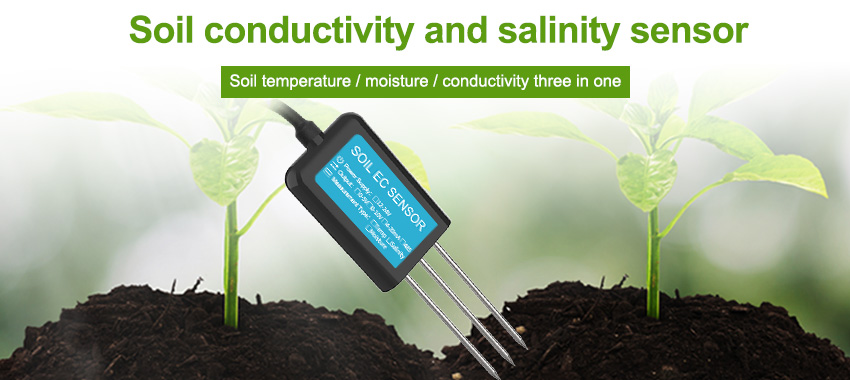Soil health is a critical factor in agricultural productivity and sustainability. Understanding the composition, moisture levels, and nutrient content of soil is essential for optimizing crop growth and maximizing yields. Traditional methods of soil testing can be time-consuming and labor-intensive. However, advancements in technology have led to the development and application of soil sensors in agriculture. These sensors provide real-time data on soil conditions, enabling farmers to make informed decisions about irrigation, fertilization, and crop management. This article explores the various applications of soil sensors in agriculture and their impact on improving soil health.

Soil Sensor Types and Functionality:
Soil sensors are designed to measure specific parameters that influence soil health and fertility. Here are some commonly used soil sensor types and their functionalities:
Moisture Sensors:
These sensors measure soil moisture content, which is crucial for determining optimal irrigation schedules. By providing real-time data on moisture levels, farmers can avoid over-irrigation or water stress, ensuring efficient water usage and preventing crop damage.
Temperature Sensors:
Soil temperature affects seed germination, nutrient availability, and microbial activity. Temperature sensors placed at different soil depths help farmers monitor variations and adjust planting schedules accordingly.
Nutrient Sensors:
These sensors measure the concentration of essential nutrients in the soil, such as nitrogen, phosphorus, and potassium. By accurately assessing nutrient levels, farmers can apply fertilizers more precisely, reducing waste and minimizing environmental impacts.
pH Sensors:
Soil pH influences nutrient availability and microbial activity. pH sensors help farmers monitor soil acidity or alkalinity, allowing them to adjust pH levels through appropriate amendments for optimal crop growth.
Salinity Sensors:
Excessive salt content in the soil can negatively impact plant health. Salinity sensors measure the electrical conductivity of soil, enabling farmers to monitor salt levels and implement appropriate measures to mitigate salinity issues.
Applications of Soil Sensors in Agriculture:
Soil sensors have a wide range of applications in agricultural practices, leading to improved soil health and increased crop yields. Here are some key applications:
Irrigation Management:
Moisture sensors provide real-time data on soil moisture levels, allowing farmers to optimize irrigation schedules. By avoiding under or over-irrigation, farmers can minimize water waste, reduce energy consumption, and prevent water stress or waterlogging in crops.
Precision Fertilization:
Nutrient sensors enable farmers to monitor soil nutrient levels accurately. This information helps them apply fertilizers precisely, avoiding excessive use and reducing nutrient runoff into water bodies. Precision fertilization improves nutrient use efficiency and minimizes environmental pollution.
Disease and Pest Management:
Soil sensors can aid in early detection of diseases and pests that affect plant roots. Changes in soil moisture, temperature, or nutrient levels can indicate potential issues, enabling farmers to take timely preventive or curative measures to protect crops.
Soil Erosion Monitoring:
Soil sensors placed at different depths can help monitor soil erosion by measuring soil moisture levels and detecting changes in soil structure. This information allows farmers to implement erosion control practices and prevent soil degradation.
Crop Rotation and Cover Crop Management:
Soil sensors assist in determining the appropriate timing for crop rotation and cover crop planting. By monitoring soil conditions, farmers can select cover crops that enhance soil fertility, reduce nutrient leaching, and improve soil structure.
Advancements in Soil Sensor Technology:
As technology continues to advance, soil sensor technology is evolving to provide more accurate and detailed information about soil health. Here are some notable advancements:
Wireless Connectivity:
Soil sensors equipped with wireless connectivity can transmit data in real-time to a centralized system, enabling farmers to access and analyze information remotely. This facilitates prompt decision-making and reduces the need for manual data collection.
Integration with Precision Agriculture Systems:
Soil sensors can be integrated with other precision agriculture technologies, such as GPS and remote sensing, to create a comprehensive data-driven approach. This integration allows farmers to optimize crop management practices, reduce inputs, and maximize yields.
Soil Sensor Networks:
Deploying multiple soil sensors in a field creates a network that provides a holistic view of soil conditions. These networks can capture variations across different soil types, topography, and microclimates, enabling farmers to implement site-specific management strategies.
Advanced Data Analysis:
Soil sensor data, combined with machine learning and artificial intelligence algorithms, can provide valuable insights for decision-making. These algorithms can identify patterns, predict soil conditions, and recommend optimal management practices based on historical data.
Benefits and Implications: The use of soil sensors in agriculture offers several benefits and implications for farmers and the environment:
Improved Resource Management:
Soil sensors enable precise irrigation and fertilization, reducing water and nutrient wastage. This leads to cost savings for farmers and minimizes environmental impacts, such as groundwater contamination and eutrophication.
Enhanced Crop Productivity:
By monitoring soil conditions in real-time, farmers can optimize crop growth parameters, leading to increased yields and improved product quality. This enhances farm profitability and food security.
Sustainable Practices: Soil sensors promote sustainable agricultural practices by facilitating efficient resource utilization, reducing chemical inputs, and minimizing soil erosion. They contribute to long-term soil health and the preservation of natural resources.
Data-Driven Decision Making: The availability of accurate and timely soil sensor data empowers farmers to make informed decisions regarding irrigation, fertilization, and pest management. This leads to more precise and effective farming practices.
Adoption Challenges: While soil sensors offer numerous benefits, their widespread adoption faces challenges such as high initial costs, technical complexity, and the need for training and support. Overcoming these challenges will require collaboration among researchers, technology providers, and policymakers.

Conclusion: Soil sensors are revolutionizing agricultural practices by unlocking the secrets of soil health. By providing real-time data on soil moisture, temperature, nutrients, pH, and salinity, these sensors enable farmers to make informed decisions, optimize resource management, and improve crop productivity. As technology continues to advance, soil sensor applications will become more sophisticated, integrating with precision agriculture systems and advanced data analysis techniques. The adoption of soil sensors in agriculture holds great potential for sustainable farming practices, soil conservation, and global food security.
